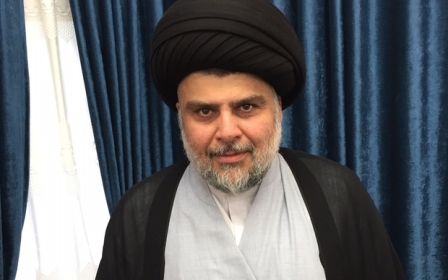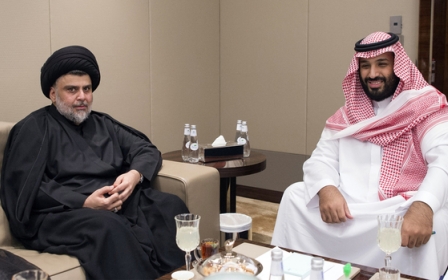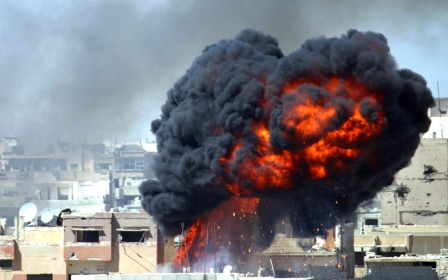Iran-US rivalry in Iraq intensifies following IS retreat

A devastating attack on an Iran-aligned component of the Iraqi Popular Mobilisation Units (PMU) earlier this week has raised tensions on the sensitive Iraqi-Syrian border.
Officials with the pro-Iranian Sayyid al-Shuhada Brigade accused the US of being behind the attack which killed at least 36 fighters and wounded 75 others, but the US has denied ordering the air strike, a position reinforced by the Islamic State (IS) group’s claims that it had killed the militiamen.
However, the sensitivity of the area, coupled with American strikes on pro-Iranian forces on the Syrian side of the border in May, gives an air of credibility to claims of possible US involvement.
More than anything, the latest incident, and the significant spike in tensions, speaks to the difficulties of managing the post-IS political and security landscape.
As Iraq prepares to launch an offensive against IS remnants in Tal Afar, the scramble to control more military and security resources is bound to intensify. The problem is compounded by the fact that Iraq is at the centre of Iranian-US regional rivalry and thus central to renewed US plans to contain Iranian influence.
Unless there is a radical departure from the current trajectory, Iraq stands little chance of fully recovering from chaos and conflict as the US and Iran continue their own battle on Iraqi territory.
Militia country
The Popular Mobilisation Units (PMU) have emerged as arguably Iraq’s most effective force against internal instability spearheaded by the IS group and its allies.
Formed in June 2014 with the blessing of Grand Ayatollah Ali Sistani, the highest Shia religious authority in Iraq, and at the height of the sweeping IS advance across northwestern Iraq, the PMU brought together dozens of Shia-led militias.
Although this was an informal arrangement – and essentially consolidated an 11-year pattern of militia growth in the post-Baathist era – it nevertheless represented a truly indigenous response to the existential threat posed by IS and its local and tribal allies.
The US-trained and sponsored Iraqi army and regular security forces had collapsed in the face of the sweeping IS advance, not because of lack of resources, but because of deep conceptual flaws. Developed and trained according to Western military concepts, the Iraqi army is not best suited to fighting counter-insurgency campaigns on home soil.
At an operational level, the PMU have acted smartly and strategically by focusing on fringe areas, for example the areas just beyond west Mosul, as opposed to getting sucked into the eye of the storm inside the city.
By extension, the PMU have led a concerted effort to secure important sections of the Iraq-Syria border, and in this way have denied IS the opportunity to regroup after it has been pushed out of urban centres.
By all credible accounts, the PMU is set to become a permanent fixture of the Iraqi political and security landscape. This is one reason all the key stakeholders in the country, notably the Iraqi government, Iran and United States, are trying to shape its future.
For the Iraqi government, the key priority is to prevent the PMU from developing into a parallel state overshadowing Iraq’s conventional armed and security forces. This anxiety has led the government to try to formally co-opt important elements of the PMU, notably the Al-Abbas Combat Division. But if this is part of a broader strategy to weaken Iran’s influence over the PMU then it is likely to backfire.
Notwithstanding competing trends in the PMU, the heart of the movement is dominated by groups firmly aligned to Iran. Perhaps no group inside the militia movement is as militarily capable as the Asaib Ahl al-Haq (AAH - League of the Righteous People).
Trained, supplied and, to some extent, directed by Iran’s Quds Force, AAH is increasingly at odds with US strategy in Iraq, particularly over the imminent assault on Tal Afar. Although the group has played a central role in laying siege to the city for months, the US and also apparently Turkey are lobbying to exclude it from the campaign.
Baghdad’s tilt toward Washington
The Iraqi government’s strategy towards the PMU is closely related to its increasingly pro-American tilt.
Specifically, the Haider al-Abadi administration is keen to strengthen the Strategic Framework Agreement, first signed back in 2008, with a view to guaranteeing long-term American engagement with Iraq.
Interestingly this shift in Iraqi government policy is reinforced by the American establishment’s apparent newfound nostalgia for the “loss” of Iraq to Iranian influence.
In view of the tight Iranian-US rivalry in Iraq, Baghdad’s shift toward Washington will inevitably produce a Iranian backlash against its neighbour. However, the Abadi administration will feel emboldened by broader political developments, notably growing fragmentation in the Shia camp.
The gadfly cleric Muqtada al-Sadr’s trip to Saudi Arabia late last month is an indicator of this fragmentation. Although his influence is much reduced from its heyday back in the days of the American occupation, Sadr continues to wield influence with working-class Iraqi Shias. Sadr has had a volatile relationship with Iran in the past 14 years, but his latest move is likely to freeze those relations for good, at least for the foreseeable future.
At a structural level, Shia politics is experiencing volatility, if not a full-blown crisis, as demonstrated by the insidious fragmentation of the Islamic Supreme Council of Iraq (ISCI), one of the bastions of the Shia political establishment.
Most worryingly for the ISCI, Ammar al-Hakim (a scion of the powerful Hakim family) has now formally left the organisation to form a new group called the National Wisdom Movement.
These developments are bad news for Iran as it potentially undermines the Islamic republic’s influence over the Baghdad-based political establishment. The perception of a loss of political influence will likely prompt Iran to invest more heavily in the PMU with a view to aligning it more closely with Iranian geopolitical interests.
In immediate terms, this may draw the PMU into the conflict in neighbouring Syria, where Iran’s key priority now is to secure access to sensitive points of the Iraq-Syria border. Longer term, divisions in the PMU will derail Iraq’s attempts to establish a coherent national security infrastructure.
The prospects do not look positive in light of the Trump administration’s belligerent rhetoric on Iran and its declared policy of containing regional Iranian influence.
Inside Iraq, any serious steps in this direction will likely reproduce the events of the occupation era when the “special” groups – now embedded in the heart of the PMU – inflicted painful losses on US forces.
- Mahan Abedin is an analyst of Iranian politics. He is the director of the research group Dysart Consulting.
The views expressed in this article belong to the author and do not necessarily reflect the editorial policy of Middle East Eye.
Photo: A woman reacts over a coffin of an Iraqi fighter from the Sayyid al-Shuhada Brigade, who was killed near the Iraqi Syrian border, during the funeral in Najaf, Iraq on 8 August 2017 (AFP)
New MEE newsletter: Jerusalem Dispatch
Sign up to get the latest insights and analysis on Israel-Palestine, alongside Turkey Unpacked and other MEE newsletters
Middle East Eye delivers independent and unrivalled coverage and analysis of the Middle East, North Africa and beyond. To learn more about republishing this content and the associated fees, please fill out this form. More about MEE can be found here.





